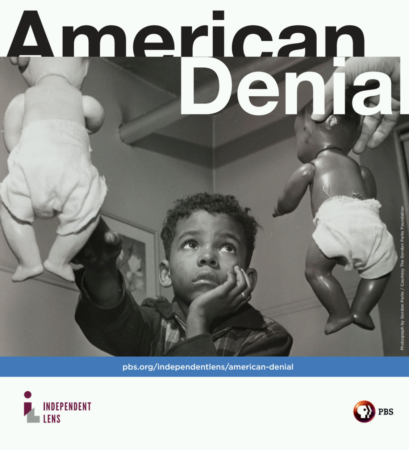 The Emmy award-winning PBS documentary showcase Independent Lens is currently streaming on its website – for FREE – ten popular feature documentaries united by the creative freedom, artistic achievement, and unflinching visions of independent filmmakers. Through Saturday, March 18, at pbs.org/independentlens, the ten films include some of the most acclaimed titles from the over 350 films that have been broadcast on Independent Lens since its launch on PBS in 2003.
The Emmy award-winning PBS documentary showcase Independent Lens is currently streaming on its website – for FREE – ten popular feature documentaries united by the creative freedom, artistic achievement, and unflinching visions of independent filmmakers. Through Saturday, March 18, at pbs.org/independentlens, the ten films include some of the most acclaimed titles from the over 350 films that have been broadcast on Independent Lens since its launch on PBS in 2003.
The full list of ten titles including in this initiative, along with summaries of each, follow below:
— “American Denial” by Llewellyn Smith
In 1938, Swedish sociologist Gunnar Myrdal began his landmark study of race and inequality in the United States. His question: How could a people who cherish freedom and fairness also create such a racially oppressive society? Seventy years later, Myrdal’s question continues to challenge America: how do we explain the disconnect between what we believe and what we practice?
— “As Goes Janesville” by Brad Lichtenstein
This verité documentary records two years in the lives of laid-off workers, business leaders, and elected officials all trying to reinvent their lives and their midwestern town amid the closure of their GM plant and America’s worst economic crisis since the Great Depression. The story begins shortly after the factory closed in 2008 and continues through a standoff between the newly elected governor and 14 Democratic state senators.
— “Blood Brother” by Steve Hoover
Why would someone leave everything behind to devote their life to helping others? Director Steve Hoover explores that question in this remarkable story of his long-time friend Rocky Braat, who did exactly that. A young man from a fractured family and a troubled past, Braat went traveling through India without a plan. There he met a group of HIV-positive children living in an orphanage — a meeting that changed everything for him. Winner of the 2014 Grand Jury Prize at the Sundance Film Festival.
— “Crips and Bloods: Made in America” by Stacy Peralta
A cluster of neighborhoods in the heart of Southern California is home to two of America’s most infamous gangs, the Crips and the Bloods. Narrated by Forest Whitaker, Crips And Bloods: Made in America combines in-depth interviews with current and former gang members, educators, historians, family members, and experts with archival and present-day footage to graphically portray the rivalry between African American gangs in South Los Angeles.
— “The House I Live” In by Eugene Jarecki
For over 40 years, the war on drugs has resulted in more than 45 million arrests, $1 trillion dollars in government spending, and America’s role as the world’s largest jailer. Yet for all that, drugs are cheaper, purer, and more available than ever. Filmed in more than 20 states, The House I Live In captures heart-wrenching stories of those on the front lines — from the dealer to the grieving mother, the narcotics officer to the senator, the inmate to the federal judge — and offers a penetrating look at America’s longest war.
— “Jiro Dreams of Sushi” by David Gelb
An elegant meditation on work, family, and the art of perfection, this film is the story of 85-year-old Jiro Ono, owner and meticulous chef of a tiny Tokyo sushi restaurant. Despite humble appearances, the restaurant is the first of its kind to be awarded a prestigious three-star Michelin review, and sushi lovers around the world call months in advance for a reservation.
— “King Corn” by Aaron Woolf
Two recent college grads discover where America’s food comes from when they plant a single acre of corn and follow it from the seed to the dinner plate. With the help of government subsidies, genetically modified seeds, and powerful herbicides, America’s most subsidized crop has become the staple of its cheapest and most troubling foods.
— “Let the Fire Burn” by Jason Osder
Using archival news coverage and interviews, Let the Fire Burn brings to life one of the most tumultuous but largely forgotten clashes between government and citizens in modern U.S. history, as a longtime feud between Philadelphia police and the controversial urban group MOVE came to a tragic climax in 1985.
— “Marwencol” by Jeff Malmberg
In 2000, Mark Hogancamp was attacked outside a bar and almost beaten to death. Revived by paramedics, he seeks recovery in Marwencol, a 1/6th-scale World War II-era town that he creates in his backyard. When his stunningly realistic photos of Marwencol are discovered and published in an art magazine, Mark’s homemade therapy suddenly becomes “art,” forcing him to make a choice between the safety of his fictional town and the real world he’s avoided since his attack.
— “Twin Sisters” by Mona Friis Bertheussen
In Twin Sisters, twin girls are adopted in China as infants by two different sets of parents — one from California, the other from a remote fishing village in Norway. The girls grow up knowing they have a twin living on the other side of the world, and although language is a barrier, the bond between them grows deeper.
To watch any of these films from now through the 18th of March, and for more information, go to pbs.org/independentlens. Join the conversation: facebook.com/independentlens and on Twitter @IndependentLens.

